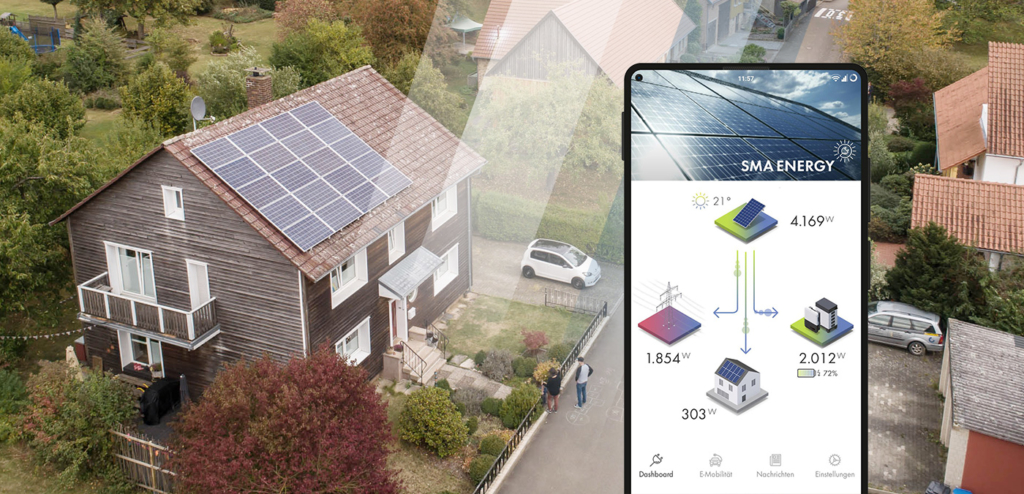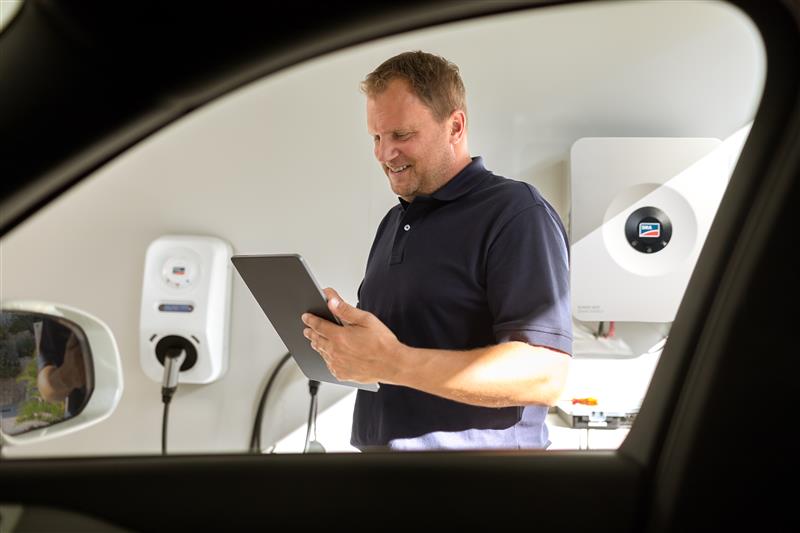Sunny Boy Smart Energy: The First PV Inverter With an Integrated Battery

The Sunny Boy Smart Energy combines a PV inverter and a lithium-ion battery and is the heart of the SMA Integrated Storage System solution for simple, intelligent energy management. In an interview, Product Manager Thomas Thierschmidt describes to me this innovative combination solution, its use and benefits—and some of the challenges the engineers had to overcome with this project.
Thomas, how did SMA come up with the idea of this combined solution?
Martin Rothert, Department Head of Product Management for Battery Inverter Technology, and Volker Wachenfeld, Senior Vice President for Hybrid and Storage, came up with the idea while they sat in a meeting with an automaker and watched a presentation illustrating the costs for lithium-ion batteries in hybrid vehicles. That’s when we came up with the idea of combining inverter and battery technology. As described in the very intriguing article From the idea to the implementation, it was an unexpectedly rocky path to get from the idea to the actual starting line.
What special challenges did you face?
With the Sunny Boy Smart Energy solution, SMA is pursuing a solar technology concept that is unique on the market. However, it also meant that a completely new certification process was necessary. Unfortunately, this proved more time-consuming than expected—both for SMA and the independent certification institutions. For example, the process required developing special standards and test procedures and then applying them. This meant that the certification “machinery” worked slower than initially planned, which put the new solution on the starting line later than expected. But now all hurdles have been overcome and all necessary field tests completed so that the product can finally be launched on the market. Last October, 50 employees were involved in the field tests, with 400 customers joining the test process in February. It is important to us to offer customers maximum reliability and performance, especially with such a complex system approach.
How important is the Sunny Boy Smart Energy for the energy transition in residential PV systems?
Simply put: Generating PV energy is critical for the energy transition. However, we need a decentralized power storage system to take the next step in the energy transition. The goal has to be to optimize the local supply, compensate the fluctuating power supply in the utility grid and support utility grid control. In order to quickly achieve storage capacity that is relevant to the system, the market needs an easy-to-install and affordable product. This is the only way to ensure success in the mass market—and as a result—a successful energy transition.
How is the Sunny Boy Smart Energy relevant as part of the SMA Smart Home?
Using SMA radio-controlled sockets to activate household loads at specified times SMA Smart Home, also known as load shifting, is one of the SMA Smart Home functions that you can experience directly. However, the loads that can be shifted in the household are limited: Power-hungry appliances such as stoves, vacuum cleaners or irons cannot be automatically activated at defined times. The battery in the Sunny Boy Smart Energy comes into play, for example, when you want to cook dinner in the evening or have surplus PV energy, which you can save for later use. In addition, the Sunny Boy SE and the Sunny Home Manager are the ultimate team when it comes to using the storage system so that no revenue is lost due to the prescribed active power limitation.
Can you briefly explain what else you need in addition to the Sunny Boy Smart Energy for easy energy management and how it works?
In addition to the Sunny Boy SE, you need PV modules on the roof, and the Sunny Home Manager and the SMA Energy Meter. The PV power is either consumed immediately in the home or stored in the battery for later use. Excess solar power is fed into the utility grid for compensation only when the battery is full or shouldn’t be charged for other reasons, such as forecasts for active power limitations. The SMA Energy Meter measures the energy exchange with the utility grid extremely accurately and makes the measured values available to the Sunny Home Manager. Now, the key element is the Sunny Home Manager that knows how long the sun will shine during the day and therefore ideally plans for consumption and intermediate storage and feeds the power into the utility grid. It does all of this taking the “70-percent rule” into consideration. With the SMA Energy Meter continuously measuring performance, the goal is to keep both purchased electricity and grid feed-in as low as possible and to directly power the home as much as possible using inexpensive solar power generated on the roof.
Why does the Sunny Boy Smart Energy feature such a “small” storage system of “only” 2 kilowatt-hours?
It may not occur much with one or the other owner-operator, but our vast experience with storage systems confirms it time and time again. You can effectively work with this storage system and what’s more—it is affordable at the same time. More exactly: The increased self-consumption stagnates with increasing battery capacities, i.e., even with a considerably larger storage capacity, you cannot achieve correspondingly higher self-consumption levels. Because you have to spend more money for a larger battery, reasonable battery capacity is essential. Moreover, customers can use such a “small” battery for almost the entire year. In contrast, you cannot fully charge a large storage system in the winter and you almost can’t use the numerous kilowatt-hours stored during the short summer nights before the PV system starts producing electricity at sunrise. In most cases, it is fairly counterproductive because you pay for a storage system that you use only to a limited degree.
Why was the battery designed with a 10-year service life? What advantages does this offer?
First, with a 10-year design, you no longer have to maintain such a high gross capacity level. Put another way, this means that a number of battery suppliers must ensure a high capacity level with a 20-year design to achieve an acceptable net capacity with a lower depth of discharge (DoD). With the Sunny Boy SE, we have a depth of discharge of greater than 90 percent for over 10 years—this allows the system to use almost the entire battery and be correspondingly smaller. This was the only way for it to be integrated completely into a device that can be mounted on the wall. In addition, owner-operators save money because the replacement battery will cost quite a bit less in 10 years. Another advantage is that the outage and error risk is considerably lower by operating two batteries for ten years each compared to operating a single battery for over 20 years. In a nutshell: The total costs are considerably lower over the span of 20 years, there is less risk and the necessary initial investment is lower.
Which customers should be interested in the Sunny Boy Smart Energy?
The Sunny Boy SE is ideal for new small-scale PV systems where the focus is on simply increasing self-consumption and not protecting against blackouts—which are very improbable here. The clear arguments include, for starters, easy, around-the-clock use of self-produced solar power. Second, you can increase your self-consumption quota from approximately 30 to 55 percent in typical household applications. Thirdly, the annually available PV power can be almost completely used up because the downward-regulating energy can be stored temporarily in most cases. Fourthly, the system with the Sunny Boy SE and the Sunny Home Manager can be adapted individually to the specific needs of the customer. And, finally, a PV system equipped with the Sunny Boy Smart Energy and Sunny Home Manager ensures a secure investment for the future thanks to the maximum Smart Grid compatibility.
Do owner-operators also qualify for the storage subsidy with the SMA Integrated Storage System, including the Sunny Boy Smart Energy?
Short and sweet – yes.
Why can’t users retrofit the Sunny Boy Smart Energy?
In principle, users can retrofit it. The challenge in this, however, is that an inverter is already installed in the existing PV system, which, as a rule, should not be replaced. Logically, this is therefore not a standard case. For such situations, we offer our SMA Flexible Storage System, a variable storage solution for new and retrofit PV systems. It is coupled on the AC side, which provides flexibility when selecting the location, battery capacity and inverter.
In conclusion, why should I decide to purchase a Sunny Boy Smart Energy?
The customer has the prospect of becoming more independent from rising energy prices by using an energy management system designed for optimal battery use. Furthermore, they can benefit from upcoming developments, for example, those resulting from our cooperation with companies such as Miele, Stiebel Eltron and Vaillant. Over the next few years, the installer can offer a successful, affordable storage solution, which, in turn, also results in easier installation and lower costs. After all, the Sunny Boy Smart Energy did not win the Intersolar Award 2013 for nothing.
Thomas, thank you for taking the time for this interview.
For more information, please visit our links
Product page – Sunny Boy Smart Energy
Sunny Boy Smart Energy receives Intersolar Award 2013





Hi,
Have a few questions:
(1) Is product still available ?
(2) Has the battery size increased ?
(3) Is the sunny boy storage replacing the Sunny Boy Smart Energy soon ?
Hello Mru,
Please contact the SMA Service for further support, using our SMA Online Service Center.
Alternatively, you may get in contact with your local installer for further direct support.
Best regards
Christiane
Hi, is this product available in the USA?
Regards
Hi Eduard,
many thanks for your interest in Sunny Boy Smart Energy: The First PV Inverter With an Integrated Battery – unfortunately not – we supply only to United Kingdom, Italy and Germany at the moment.
Please contact our subsidiary in the US for further information and update on this.
Many thanks.
Horst